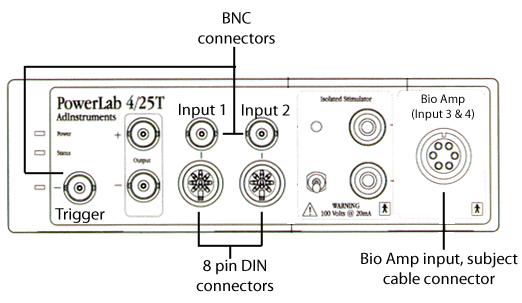|
Biomedical Signals Acquisition |
Computerized recording system |
| |
In all the laboratory sessions concerned
with the acquisition of electrophysiological data, we will use
a complete system that acquires,
amplifies and transforms the signal into a digital one and sends it to
the computer via a special port (USB).
It is of value to look at the different possible connections and
ancillary equipment used for specific tasks. |
|
|

Setup used in the first
laboratory: the sine wave is generated by the waveform generator (left),
which is connected via a "BNC" connector to one of the channels of the
Powerlab unit, and then processed further by the hardware and software.
Cables with special electrodes are also connected to the BioAmplifier
(right): this isolated amplifier can be connected to a subject. |
|
The signal acquisition
system |
|
Input (coaxial)
BNC or 8-pin DIN connectors
Analogue input BNC
connectors are used to record external signals, either directly, or by
adding high impedance pre-amplifiers (as in the case of the resting
membrane potential lab) . The 8-pin DIN connectors allow to record
external inputs from signal conditioners, such as “pods”. The EOG pod
uses the steady corneal-retinal potential to detect eye movement and
position. It is electrically isolated and safe for human use (the EOG
will not be demonstrated this year). |
 |
|
The trigger BNC
connector allows for an external signal to synchronize recording with an
external event. You will be using this feature during the Compound
Action Potential lab. An external stimulator (Grass SD9) will be
connected to this trigger and synchronization between recording and
stimulation of the nerve will occur. |
The Bio Amp input
provides access to dual isolated differential amplifiers with a common
ground- safe for human use in a teaching context-. The signals from this
connector are recorded on input channels 3 and 4 of the Powerlab.
Bioelectrical potential signals (EEG, EOG, ECG, EMG) can be recorded
using the subject cable and lead wires supplied with the unit.
|
|
Click here to continue with the next section: the waveform acquisition |
| |
| |
| |
| |
| |
|
| |
| |
| |
|
| |
| |
|
|